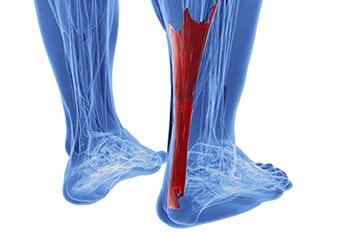What is the Achilles Tendon?

The Achilles tendon is the largest tendon in the body. The Achilles tendon is located at the back of the lower leg and connects the calf muscle to the heel bone. The chief function of the Achilles tendon is to bring the ankle and foot downwards and push the body forward during ambulation. The Achilles tendon has an asymmetric insertion on the heel and this causes uneven forces during running or jumping and these activities predispose it to acute or chronic injury.
What causes Achilles Tendon Injuries?
Overuse is a common cause of Achilles tendon injuries because it puts too much stress on the tendon too quickly. The ongoing stress on the tendon too quickly causes micro tears of the tendon and the body is not able to repair itself. This results in pain because the structure of the tendon is altered. Work that causes stress on the foot and ankle such as for laborers causes Achilles injuries as well those that are less conditioned and increase their physical activity too quickly (weekend warriors). Patients with excessive flattening of the arch and a tight Achilles tendon have a tendency to develop Achilles injuries because of an increase in tension on the tendon.
Symptoms of an Achilles Tendon Injury
Symptoms include pain, stiffness, soreness and tenderness anywhere along the tendon. There can also be an intense pain when the sides of the tendon are squeezed. There is an increase in pain when the ankle is stretched and when standing on your toes. Pain may be mild and gradually worsen with Achilles tendonitis. When the disorder progresses to degeneration such as in Achilles tendinosis, the tendon may become enlarged and nodules may develop in the area where the tissue is damaged. Hearing a snapping or popping noise and having abrupt severe pain may be a sign of a rupture and potential for a complete tendon tear.
Diagnosis of Achilles Tendon Injuries
Diagnosis is achieved by clinical examination. Tightness of the tendon will be evaluated as well as any palpable nodules or spurs. Digital x-rays will be obtained in the office to evaluate if there is a heel spur present at the back of the heel as well as any calcifications within the tendon. An MRI is ordered for those patients with chronic tendinosis and when tearing or rupture of the tendon is suspected.
Common Achilles Tendon Injuries
This is an inflammation of the Achilles tendon. The inflammation is typically short and if not resolved the condition causes degeneration of the tendon. This is typically a condition of overuse. There is a direct correlation between tendonitis and the intensity of training for running or jumping activities. Patients report a change in frequency or duration of training habits. There is also a change in running surfaces or wearing shoes without proper support. Having tight calf muscles also contributes. Patients describe burning pain and swelling after activity. There is usually swelling, warmth, and tenderness throughout active and passive range of motion. Conservative treatment includes nonsteroidal anti-inflammatory medication, ice, stretching, and modification of training surfaces and or shoe wear as well as orthotics. A brace or boot will be used to immobilize the tendon during healing and all physical activity will be decreased that stresses the tendon. Advanced non-invasive treatments include Topaz. Topaz is performed in the operating room and small holes are made in the tendon to stimulate growth factors and healing.
Tendinosis is degeneration of the tendon, which is when Achilles tendonitis becomes a chronic condition. This usually occurs in an older population or when the initial injury was not properly treated early on. Once the condition has become chronic it is harder to treat. Patients describe variable degrees of symptoms that range from painless stiffness to severe, restricted, painful weight bearing. Examination shows a palpable nodular thickening of the tendon as well as an asymmetry in the width of the tendon. Conservative treatment is the same as for Achilles tendonitis. For symptoms resistant to conservative treatment surgical treatment is an option. Surgery is needed to remove any damaged or scarred tissue that is present. The surgery may leave a defect and a graft may be needed to augment the tendon repair. The patient will need to be immobilized in a cast for a minimum of 6 weeks.
Acute ruptures of the Achilles tendon are common and typically occur during athletic activity. Most injuries occur in poorly conditioned athletes so-called weekend warriors. Patients typically push off or land when the foot is in a downward position and experience a palpable/audible pop or kick to the back of the leg while running or jumping. They also describe resultant weakness and the inability to push off. There is a sudden sharp pain, immediate swelling and bruising. Diagnosis is usually clinical and the integrity of the tendon is tested by squeezing the calf muscle while the patient is lying on their stomach. Conservative treatment is an option if the Achilles tendon is partially torn. A walking boot or cast is applied to immobilize the tendon. If the tendon is completely ruptured surgery is generally required to reattach the tendon followed by a minimum of 6 weeks in a cast.
